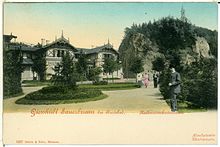Hydropathic Institute (Kyselka)
The hydropathic facility in Kyselka (German: Gießhübl Sauerbrunn ) near Karlsbad in the Czech Republic is one of the earlier spa facilities of the former spa, which were built in the 19th century. At the beginning of the 20th century, the facility was replaced by more modern spa facilities that corresponded to the taste of the time and from then on it was used by the Heinrich von Mattoni company as part of the bottling facilities for the famous Gießhübler mineral water . A large part of the building is still there today in a partially converted form.
history
The Buchsäuerling or Rodisforter Sauerbrunn, which originated in the Egertal and was already known in the late Middle Ages, below today's Buchkoppe between Karlsbad and Rodisfort , called König-Otto-Quelle since 1852 , was built over in 1853 with a fountain temple with subsequent colonnade. The influx of visitors from Karlovy Vary increased significantly, so that in addition to the numerous day guests, spa guests with longer stays also had to be accommodated. In particular after Heinrich Mattoni bought the place in 1873, considerable financial resources were invested in the expansion of the health resort. At the Kreuzberg rocks were blown up and a hydropathic institute was built in their place. In this cold water baths with the Gießhübler Sauerbrunnen were offered and used by numerous guests, for whom overnight accommodations were created on the upper floor of the building.
A spacious drinking hall with a dome was built in the adjacent garden, which was given its new place in a park on the opposite side of the Eger at the beginning of the 20th century.
After the end of the Second World War, the Mattoni company (joint stock company) was run by the state-owned company Západočeská zřídla in Karlovy Vary, which was converted into Karlovarské minerálni vody (Czech for Karlovy Vary mineral water ) in 1990 and became the largest mineral water company in the Czech Republic. A modern bottling plant was built in the late 1980s and modernized in the 1990s. Some of the historic buildings of the spa and hydrotherapy facility are still there today.
literature
- Anton Gnirs : Topography of the historical and art-historical monuments in the Karlsbad district. Prague 1933 (= Handbook of Sudeten German Cultural History. Vol. 8). Published by the Collegium Carolinum. Obtained from Anna Gnirs. Oldenbourg, Munich 1996, ISBN 3-486-56170-7 , p. 39.
Individual evidence
- ↑ Löschner: The Curort Giesshübl-Puchstein , 8th edition. 1875



